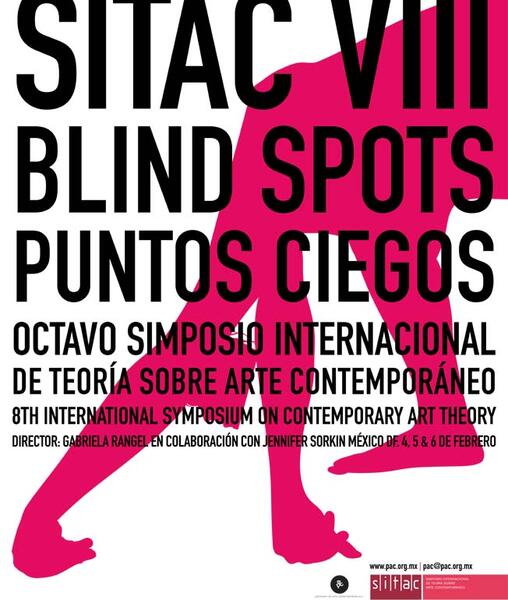Eight Edition of SITAC
as every year, would be conducted by Gabriela Rangel with the collaboration of Jeniffer Sorkin and will focus on a reflection on those “radical speeches and practices- like feminism, film and performance- that have generated blind spots in the theory and criticism of contemporary art.”

The proposal departs from the consideration that blindness is not a defect, but a present condition in the eye. The “blind spot” of Mariotte is a spot situated in the retina where the reception of luminous rays does not occur due to the absence of photoreceptors. SITAC has focused in following these “blind spots” in the following areas:
Feminism and Genre
Feminism played a big part in the reverting of a vision that is very formalistic, theological and, therefore, excludes modernism. It is not causal that it operated using hybrid practices like dance, performance, film, and experimental video to demonstrate a visual alternative to the fine arts tradition, to open circuits in the margin of museums and to display realities as well as peripheral subjects.
The Influence of Film in the Visual Arts
The image-movement discussion that will be articulated during the SITAC VIII aspires to consider film as a language that has colonized and transformed radical artistic practices influenced by feminism, genre studies and post-colonial theory. Film requires a theoretical approximation that is not reduced to the modernistic European frontline, and that aspires to explore mechanisms of memory and time.
Performance
Performance allied with feminism arises historically in the visual arts as a form of hybrid theater that by uniting sculpture painting, dance, poetry, video and music was able to break out from the confinements of the museum. The inevitable adaptation of performance art to the professionalization of artists, to the demands of the market and the institutional requirements of art, has produced visible changes in the way we approach new roles and expectations. Another thing that has changed is that the expropriation and/or discursive fictions while representing and interpreting the documentation of performances is becoming more legit. SITAC VIII proposes to examine blind spots in the historiography as well as the criticism that have transformed this expression into a canonic practice, and its history into theater.
Puntos Ciegos/Blind Spots
will develop through a general program that counts with diverse sessions that touch themes like “The exhausted painting”; “Write your own story: story of auto institutionalization”; “Does the political equal the private?” and “Gender spaces”/ This sessions are complemented with magisterial speeches by recognized national and international specialists like James Coleman, Tom McDonough, Rita Eder, amongst others; and the showing of movies, fixed images, and performance like the one Carlos Amorales will perform.
Clinics
Parallel to this edition, the committee for the International Theory of Contemporary Art Symposium will realize a series of clinics and workshops, through de new dynamic of integration of the SITAC project. Under the direction of Tobias Ostrander, these discussion groups will be designed by artists and curators that work in Mexico with the help of foreign artists and theorists that will participate as speakers at the SITAC VIII. From the themes of the clinics stand out: " Faking it / El simulacro, actuando la masculinidad"; "Interiores, exteriores, y la construcción de espacios de género" and "Goddamned Films".
Participants:
Carlos Amorales, Vasco Araujo, Kader Attia, Klaus Biesenbach, Sabine Breitwieser, James Coleman, Dias & Riedweg, Rita Eder, Michèle Faguet, Silvia Gruner, Barbara London, Tom McDonough, Lane Relyea, Martha Rosler, Jennifer Sorkin and Judi Werthein.
Patronage of Arte Contemporáneo A.C. Palmas #820 Floor 3, Lomas de Chapultepec, Mexico, D.F. 11000 Phone.: (52)(55)52.84.03.60 Ext. 295 y 395 Fax: (52)(55)55.40.83.94 Mayor information: http://www.pac.org.mx/ pac@pac.org.mx




